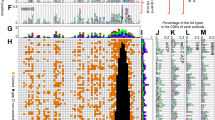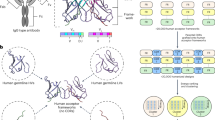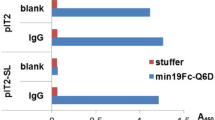Abstract
GENERAL acid–base catalysis contributes substantially to the efficacy of many enzymes, enabling an impressive array of eliminations, isomerizations, racemizations, hydrolyses and carbon–carbon bond-forming reactions to be carried out with high rates and selectivities1. The fundamental challenge of exploiting similar effects in designed catalysts such as catalytic antibodies2,3 is that of correctly positioning the catalytic groups in an appropriate active-site microenvironment. Charge complementarity between antibody and hapten (the template used to induce an antibody) has been used successfully in a number of instances to elicit acids and bases within immunoglobulin combining sites4–9, but the activities of the catalysts obtained by this strategy are generally considerably lower than those of natural enzymes. Here we report that by optimizing hapten design and efficiently screening the immune response, antibodies can be obtained that act effectively as general base catalysts. Thus a cationic hapten correctly mimicking the transition-state geometry of all reacting bonds and bearing little resemblance to the reaction product has yielded carboxylate containing antibodies that catalyse an E2 elimination with more than 103 turnovers per active site and rate accelerations of greater than 108. These results demonstrate that very large effects can be achieved by strategic use of haptenic charge.
This is a preview of subscription content, access via your institution
Access options
Subscribe to this journal
Receive 51 print issues and online access
$199.00 per year
only $3.90 per issue
Buy this article
- Purchase on Springer Link
- Instant access to full article PDF
Prices may be subject to local taxes which are calculated during checkout
Similar content being viewed by others
References
Walsh, C. Enzymatic Reaction Mechanisms (Freeman, New York, 1979).
Lerner, R. A., Benkovic, S. J. & Schultz, P. G. Science 252, 659–667 (1991).
Hilvert, D. Curr. Opin. struct. Biol. 4, 612–617 (1994).
Shokat, K. M., Leumann, C. J., Sugasawara, R. & Schultz, P. G. Nature 338, 269–271 (1989).
Janda, K. D., Weinhouse, M. I., Schloeder, D. M., Lerner, R. A. & Benkovic, S. J. J. Am. chem. Soc. 112, 1274–1275 (1990).
Jackson, D. Y. & Schultz, P. G. J. Am. chem. Soc. 113, 2319–2321 (1991).
Uno, T. & Schultz, P. G. J. Am. chem. Soc. 114, 6573–6574 (1992).
Reymond, J.-L., Jahangiri, G. K., Stoudt, C. & Lerner, R. A. J. Am. chem. Soc. 115, 3909–3917 (1993).
Shokat, K., Uno, T. & Schultz, P. G. J. Am. chem. Soc. 116, 2261–2270 (1994).
Casey, M. L., Kemp, D. S., Paul, K. G. & Cox, D. D. J. org. Chem. 38, 2295–2301 (1973).
Kemp, D. S. & Casey, M. L. J. Am. chem. Soc. 95, 6670–6680 (1973).
Kemp, D. S., Cox, D. D. & Paul, K. G. J. Am. chem. Soc. 97, 7312–7318 (1975).
Harlow, E. & Lane, D. Antibodies: A Laboratory Manual (Cold Spring Harbor Lab., New York, 1988).
Hilvert, D., Carpenter, S. H., Nared, K. D. & Auditor, M. T. M. Proc. natn. Acad. Sci. U.S.A. 85, 4953–4955 (1988).
Lundblad, R. L. Chemical Reagents for Protein Modification 2nd edn 267–286 (CRC, Boca Raton, 1991).
Parker, A. J. Chem. Rev. 69, 1–32 (1969).
Kirby, A. J. Adv. phys. org. Chem. 17, 183–278 (1980).
Warshell, A. Computer Modeling of Chemical Reactions in Enzymes and Solutions 153 169, 208–228 (Wiley, New York, 1991).
Jencks, W. P. Adv. Enzymol. 43, 219–408 (1975).
Gerlt, J. A., Kozarich, J. W., Kenyon, G. L. & Gassman, P. G. J. Am. chem. Soc. 113, 9667–9669 (1991).
Kuliopulos, A., Talalay, P. & Mildvan, A. S. Biochemistry 29, 10271–10280 (1990).
Cravatt, B. F., Ashley, J. A., Janda, K. D., Boger, D. L. & Lerner, R. A. J. Am. chem. Soc. 116, 6013–6014 (1994).
Lauer, R. C., Soloman, P. H., Nakanishi, K. & Erlanger, B. F. Experiencia 30, 560–562 (1974).
Habeeb, A. F. S. A. Analyt. Biochem. 14, 328–336 (1966).
Author information
Authors and Affiliations
Rights and permissions
About this article
Cite this article
Thorn, S., Daniels, R., Auditor, MT. et al. Large rate accelerations in antibody catalysis by strategic use of haptenic charge. Nature 373, 228–230 (1995). https://doi.org/10.1038/373228a0
Received:
Accepted:
Issue Date:
DOI: https://doi.org/10.1038/373228a0
This article is cited by
-
A redox-mediated Kemp eliminase
Nature Communications (2017)
-
Organic–inorganic supramolecular solid catalyst boosts organic reactions in water
Nature Communications (2016)
-
Characterization and mechanism insight of accelerated catalytic promiscuity of Sulfolobus tokodaii (ST0779) peptidase for aldol addition reaction
Applied Microbiology and Biotechnology (2015)
-
Precision is essential for efficient catalysis in an evolved Kemp eliminase
Nature (2013)
-
Designing artificial enzymes by intuition and computation
Nature Chemistry (2010)
Comments
By submitting a comment you agree to abide by our Terms and Community Guidelines. If you find something abusive or that does not comply with our terms or guidelines please flag it as inappropriate.



